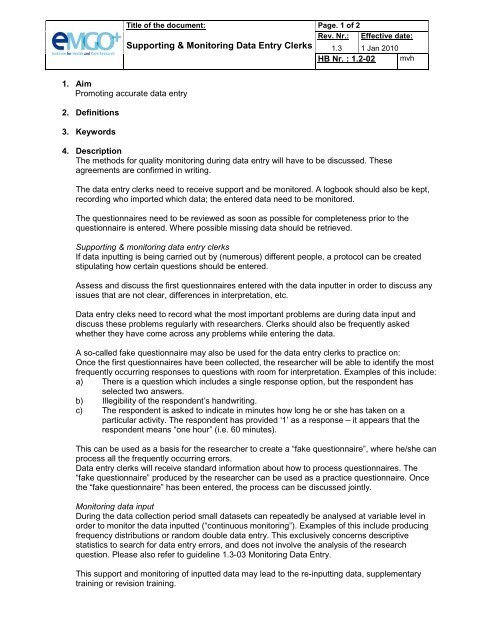2 Supporting and monitoring data entry clerks - EMGO
2 Supporting and monitoring data entry clerks - EMGO 2 Supporting and monitoring data entry clerks - EMGO
Title of the document:Supporting & Monitoring Data Entry ClerksPage. 1 of 2Rev. Nr.: Effective date:1.3 1 Jan 2010HB Nr. : 1.2-02 mvh1. AimPromoting accurate data entry2. Definitions3. Keywords4. DescriptionThe methods for quality monitoring during data entry will have to be discussed. Theseagreements are confirmed in writing.The data entry clerks need to receive support and be monitored. A logbook should also be kept,recording who imported which data; the entered data need to be monitored.The questionnaires need to be reviewed as soon as possible for completeness prior to thequestionnaire is entered. Where possible missing data should be retrieved.Supporting & monitoring data entry clerksIf data inputting is being carried out by (numerous) different people, a protocol can be createdstipulating how certain questions should be entered.Assess and discuss the first questionnaires entered with the data inputter in order to discuss anyissues that are not clear, differences in interpretation, etc.Data entry cleks need to record what the most important problems are during data input anddiscuss these problems regularly with researchers. Clerks should also be frequently askedwhether they have come across any problems while entering the data.A so-called fake questionnaire may also be used for the data entry clerks to practice on:Once the first questionnaires have been collected, the researcher will be able to identify the mostfrequently occurring responses to questions with room for interpretation. Examples of this include:a) There is a question which includes a single response option, but the respondent hasselected two answers.b) Illegibility of the respondent’s handwriting.c) The respondent is asked to indicate in minutes how long he or she has taken on aparticular activity. The respondent has provided ‘1’ as a response – it appears that therespondent means “one hour” (i.e. 60 minutes).This can be used as a basis for the researcher to create a “fake questionnaire”, where he/she canprocess all the frequently occurring errors.Data entry clerks will receive standard information about how to process questionnaires. The“fake questionnaire” produced by the researcher can be used as a practice questionnaire. Oncethe “fake questionnaire” has been entered, the process can be discussed jointly.Monitoring data inputDuring the data collection period small datasets can repeatedly be analysed at variable level inorder to monitor the data inputted (“continuous monitoring”). Examples of this include producingfrequency distributions or random double data entry. This exclusively concerns descriptivestatistics to search for data entry errors, and does not involve the analysis of the researchquestion. Please also refer to guideline 1.3-03 Monitoring Data Entry.This support and monitoring of inputted data may lead to the re-inputting data, supplementarytraining or revision training.
Title of the document:<strong>Supporting</strong> & Monitoring Data Entry ClerksPage. 1 of 2Rev. Nr.: Effective date:1.3 1 Jan 2010HB Nr. : 1.2-02 mvh1. AimPromoting accurate <strong>data</strong> <strong>entry</strong>2. Definitions3. Keywords4. DescriptionThe methods for quality <strong>monitoring</strong> during <strong>data</strong> <strong>entry</strong> will have to be discussed. Theseagreements are confirmed in writing.The <strong>data</strong> <strong>entry</strong> <strong>clerks</strong> need to receive support <strong>and</strong> be monitored. A logbook should also be kept,recording who imported which <strong>data</strong>; the entered <strong>data</strong> need to be monitored.The questionnaires need to be reviewed as soon as possible for completeness prior to thequestionnaire is entered. Where possible missing <strong>data</strong> should be retrieved.<strong>Supporting</strong> & <strong>monitoring</strong> <strong>data</strong> <strong>entry</strong> <strong>clerks</strong>If <strong>data</strong> inputting is being carried out by (numerous) different people, a protocol can be createdstipulating how certain questions should be entered.Assess <strong>and</strong> discuss the first questionnaires entered with the <strong>data</strong> inputter in order to discuss anyissues that are not clear, differences in interpretation, etc.Data <strong>entry</strong> cleks need to record what the most important problems are during <strong>data</strong> input <strong>and</strong>discuss these problems regularly with researchers. Clerks should also be frequently askedwhether they have come across any problems while entering the <strong>data</strong>.A so-called fake questionnaire may also be used for the <strong>data</strong> <strong>entry</strong> <strong>clerks</strong> to practice on:Once the first questionnaires have been collected, the researcher will be able to identify the mostfrequently occurring responses to questions with room for interpretation. Examples of this include:a) There is a question which includes a single response option, but the respondent hasselected two answers.b) Illegibility of the respondent’s h<strong>and</strong>writing.c) The respondent is asked to indicate in minutes how long he or she has taken on aparticular activity. The respondent has provided ‘1’ as a response – it appears that therespondent means “one hour” (i.e. 60 minutes).This can be used as a basis for the researcher to create a “fake questionnaire”, where he/she canprocess all the frequently occurring errors.Data <strong>entry</strong> <strong>clerks</strong> will receive st<strong>and</strong>ard information about how to process questionnaires. The“fake questionnaire” produced by the researcher can be used as a practice questionnaire. Oncethe “fake questionnaire” has been entered, the process can be discussed jointly.Monitoring <strong>data</strong> inputDuring the <strong>data</strong> collection period small <strong>data</strong>sets can repeatedly be analysed at variable level inorder to monitor the <strong>data</strong> inputted (“continuous <strong>monitoring</strong>”). Examples of this include producingfrequency distributions or r<strong>and</strong>om double <strong>data</strong> <strong>entry</strong>. This exclusively concerns descriptivestatistics to search for <strong>data</strong> <strong>entry</strong> errors, <strong>and</strong> does not involve the analysis of the researchquestion. Please also refer to guideline 1.3-03 Monitoring Data Entry.This support <strong>and</strong> <strong>monitoring</strong> of inputted <strong>data</strong> may lead to the re-inputting <strong>data</strong>, supplementarytraining or revision training.
Title of the document:<strong>Supporting</strong> & Monitoring Data Entry ClerksPage. 2 of 2Rev. Nr.: Effective date:1.3 1 Jan 2010HB Nr. : 1.2-02 mvh5. DetailsAudit questions- Has the quality <strong>monitoring</strong> of the <strong>data</strong> input been confirmed in writing?- Have the <strong>data</strong> <strong>entry</strong> <strong>clerks</strong> been trained, <strong>and</strong> if so, what does their training include? Has aprotocol or a fake list been used?- Have problems arisen during the <strong>data</strong> input? (If so, have these problems been recorded<strong>and</strong> solved?)- Have <strong>data</strong> been monitored at variable level during the <strong>data</strong> collection process?6. Appendices/references/links7. AmendmentsV1.3: 1 Jan 2010 English translation.V1.2: 8 Jul 2008, Small additionV1.1: 23 Nov 2006: Addition of use of fake list, example input protocol.



